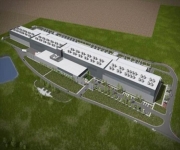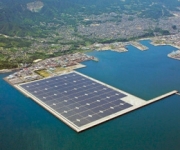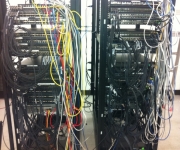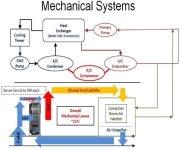Author Archive

Facebook Iowa Data Center In 2007, the EPA released a study on datacenter power consumption at the request of the US Congress (EPA Report to Congress on Server and Data Center Efficiency). The report estimated that the power consumption of datacenters represented about 1.5% of the US Energy Budget in 2005 and this number would…

I frequently get asked “why not just put solar panels on data center roofs and run them on that.” The short answer is datacenter roofs are just way too small. In a previous article (I Love Solar But…) I did a quick back of envelope calculation and, assuming a conventional single floor build with current…
At the Microsoft World-Wide Partners Conference, Microsoft CEO Steve Ballmer announced that “We have something over a million servers in our data center infrastructure. Google is bigger than we are. Amazon is a little bit smaller. You get Yahoo! and Facebook, and then everybody else is 100,000 units probably or less.” That’s a surprising data…

Back in 2009, in Datacenter Networks are in my way, I argued that the networking world was stuck in the mainframe business model: everything vertically integrated. In most datacenter networking equipment, the core Application Specific Integrated Circuit (ASIC – the heart of a switch or router), the entire hardware platform for the ASIC including power…
In the data center world, there are few events taken more seriously than power failure and considerable effort is spent to make them rare. When a datacenter experiences a power failure, it’s a really big deal for all involved. But, a big deal in the infrastructure world still really isn’t a big deal on the…
In the cloud there is nothing more important than customer trust. Without customer trust, a cloud business can’t succeed. When you are taking care of someone else’s assets, you have to treat those assets as more important than your own. Security has to be rock solid and absolutely unassailable. Data loss or data corruption has…

Since 2008, I’ve been excited by, working on, and writing about Microservers. In these early days, some of the workloads I worked with were I/O bound and didn’t really need or use high single-thread performance. Replacing the server class processors that supported these applications with high-volume, low-cost client system CPUs yielded both better price/performance and…
I’ve worked in or near the database engine world for more than 25 years. And, ironically, every company I’ve ever worked at has been working on a massive-scale, parallel, clustered RDBMS system. The earliest variant was IBM DB2 Parallel Edition released in the mid-90s. It’s now called the Database Partitioning Feature. Massive, multi-node parallelism is…
I have been interested in, and writing about, microservers since 2007. Microservers can be built using any instruction set architecture but I’m particularly interested in ARM processors and their application to server-side workloads. Today Advanced Micro Devices announced they are going to build an ARM CPU targeting the server market. This will be 4-core, 64…

When I come across interesting innovations or designs notably different from the norm, I love to dig in and learn the details. More often than not I post them here. Earlier this week, Google posted a number of pictures taken from their datacenters (Google Data Center Tech). The pictures are beautiful and of interest to…
The last few weeks have been busy and it has been way too long since I have blogged. I’m currently thinking through the server tax and what’s wrong with the current server hardware ecosystem but don’t have anything yet ready to go on that just yet. But, there are a few other things on the…
Earlier today Amazon Web Services announced Glacier, a low-cost, cloud-hosted, cold storage solution. Cold storage is a class of storage that is discussed infrequently and yet it is by far the largest storage class of them all. Ironically, the storage we usually talk about and the storage I’ve worked on for most of my life…
Facebook recently released a detailed report on their energy consumption and carbon footprint: Facebook’s Carbon and Energy Impact. Facebook has always been super open with the details behind there infrastructure. For example, they invited me to tour the Prineville datacenter just prior to its opening: · Open Compute Project · Open Compute Mechanical System Design…
In I/O Performance (no longer) Sucks in the Cloud, I said Many workloads have high I/O rate data stores at the core. The success of the entire application is dependent upon a few servers running MySQL, Oracle, SQL Server, MongoDB, Cassandra, or some other central database. Last week a new Amazon Elastic Compute Cloud (EC2)…
Many workloads have high I/O rate data stores at the core. The success of the entire application is dependent upon a few servers running MySQL, Oracle, SQL Server, MongoDB, Cassandra, or some other central database. The best design patter for any highly reliable and scalable application whether on-premise or in cloud hosted, is to shard…
Why are there so many data centers in New York, Hong Kong, and Tokyo? These urban centers have some of the most expensive real estate in the world. The cost of labor is high. The tax environment is unfavorable. Power costs are high. Construction is difficult to permit and expensive. Urban datacenters are incredibly expensive…

Facebook Iowa Data Center In 2007, the EPA released a study on datacenter power consumption at the request of the US Congress (EPA Report to Congress on Server and Data Center Efficiency). The report estimated that the power consumption of datacenters represented about 1.5% of the US Energy Budget in 2005 and this number would…

I frequently get asked “why not just put solar panels on data center roofs and run them on that.” The short answer is datacenter roofs are just way too small. In a previous article (I Love Solar But…) I did a quick back of envelope calculation and, assuming a conventional single floor build with current…
At the Microsoft World-Wide Partners Conference, Microsoft CEO Steve Ballmer announced that “We have something over a million servers in our data center infrastructure. Google is bigger than we are. Amazon is a little bit smaller. You get Yahoo! and Facebook, and then everybody else is 100,000 units probably or less.” That’s a surprising data…

Back in 2009, in Datacenter Networks are in my way, I argued that the networking world was stuck in the mainframe business model: everything vertically integrated. In most datacenter networking equipment, the core Application Specific Integrated Circuit (ASIC – the heart of a switch or router), the entire hardware platform for the ASIC including power…
In the data center world, there are few events taken more seriously than power failure and considerable effort is spent to make them rare. When a datacenter experiences a power failure, it’s a really big deal for all involved. But, a big deal in the infrastructure world still really isn’t a big deal on the…
In the cloud there is nothing more important than customer trust. Without customer trust, a cloud business can’t succeed. When you are taking care of someone else’s assets, you have to treat those assets as more important than your own. Security has to be rock solid and absolutely unassailable. Data loss or data corruption has…

Since 2008, I’ve been excited by, working on, and writing about Microservers. In these early days, some of the workloads I worked with were I/O bound and didn’t really need or use high single-thread performance. Replacing the server class processors that supported these applications with high-volume, low-cost client system CPUs yielded both better price/performance and…
I’ve worked in or near the database engine world for more than 25 years. And, ironically, every company I’ve ever worked at has been working on a massive-scale, parallel, clustered RDBMS system. The earliest variant was IBM DB2 Parallel Edition released in the mid-90s. It’s now called the Database Partitioning Feature. Massive, multi-node parallelism is…
I have been interested in, and writing about, microservers since 2007. Microservers can be built using any instruction set architecture but I’m particularly interested in ARM processors and their application to server-side workloads. Today Advanced Micro Devices announced they are going to build an ARM CPU targeting the server market. This will be 4-core, 64…

When I come across interesting innovations or designs notably different from the norm, I love to dig in and learn the details. More often than not I post them here. Earlier this week, Google posted a number of pictures taken from their datacenters (Google Data Center Tech). The pictures are beautiful and of interest to…
The last few weeks have been busy and it has been way too long since I have blogged. I’m currently thinking through the server tax and what’s wrong with the current server hardware ecosystem but don’t have anything yet ready to go on that just yet. But, there are a few other things on the…
Earlier today Amazon Web Services announced Glacier, a low-cost, cloud-hosted, cold storage solution. Cold storage is a class of storage that is discussed infrequently and yet it is by far the largest storage class of them all. Ironically, the storage we usually talk about and the storage I’ve worked on for most of my life…
Facebook recently released a detailed report on their energy consumption and carbon footprint: Facebook’s Carbon and Energy Impact. Facebook has always been super open with the details behind there infrastructure. For example, they invited me to tour the Prineville datacenter just prior to its opening: · Open Compute Project · Open Compute Mechanical System Design…
In I/O Performance (no longer) Sucks in the Cloud, I said Many workloads have high I/O rate data stores at the core. The success of the entire application is dependent upon a few servers running MySQL, Oracle, SQL Server, MongoDB, Cassandra, or some other central database. Last week a new Amazon Elastic Compute Cloud (EC2)…
Many workloads have high I/O rate data stores at the core. The success of the entire application is dependent upon a few servers running MySQL, Oracle, SQL Server, MongoDB, Cassandra, or some other central database. The best design patter for any highly reliable and scalable application whether on-premise or in cloud hosted, is to shard…
Why are there so many data centers in New York, Hong Kong, and Tokyo? These urban centers have some of the most expensive real estate in the world. The cost of labor is high. The tax environment is unfavorable. Power costs are high. Construction is difficult to permit and expensive. Urban datacenters are incredibly expensive…